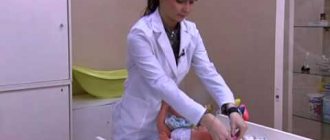Causes of omphalitis
If we talk about development factors, then most often the direct cause of the disease is non-compliance with hygiene standards and child care rules.
Most often it develops in weakened, premature children suffering from certain diseases. However, it is often primary in nature and easily treatable. If omphalitis develops against the background of an existing structural pathology (fistulas of the bladder, gallbladder, etc.), then they speak of the secondary nature of the disease.
Why does a baby's belly button smell?
One of the common reasons why a baby may smell from the navel is umbilical fistulas. “An umbilical fistula is a hole that forms precisely in this place. It can manifest itself quite early, and if the healing of the navel is not going well, or it cannot completely end, when the process with the bracket has fallen off or has been removed, and the wound continues to get wet, you need to look carefully - perhaps a hole has formed there. And against the background of healing, inflammation can easily develop in it,” says pediatrician Anna Shulyaeva.
There are several manifestations of this problem - complete and incomplete fistula. The first one is more dangerous. Indeed, in this case, the ducts can be completely open, and both urine and feces will come out through the hole. They speak of an incomplete fistula when the duct is partially open, then suppuration occurs, but without serious complications. With this problem, in addition to the smell from the navel, increased body temperature, inflammation of the umbilical ring, and swelling in this area may occur. If left untreated, diverticula, intestinal obstruction, intoxication of the body, and even peritonitis can form. The consequences will be completely sad - blood poisoning, disability and even death.
In facts and figures: the navel can heal after piercing for up to 2 years Read more
Another disease that can cause odor from a baby’s navel is omphalitis. “This is an inflammation of the skin in the umbilical wound, which can be caused by pathogens, mainly bacteria. This is a surgical pathology that needs to be treated urgently, because it is also fraught with peritonitis and inflammatory processes throughout the abdominal cavity,” says Anna Shulyaeva.
A problem develops if the infection enters through an unhealed umbilical wound. For example, this can happen if the umbilical wound is not properly cared for. In addition, diaper dermatitis can act as a provoking factor. Omphalitis, like a fistula, can manifest as a weeping wound, swelling and redness. In addition, it happens that the child’s body temperature rises.
Another reason for the appearance of odor from the navel in a child (by the way, the same problem can occur in adults, but rarely, because it is mainly diagnosed in childhood) is a Urahus cyst. “Such a defect occurs when the bladder and duct are formed incorrectly, which normally should close by 3-6 months. As a result, an appendage forms near the bladder, in which fluid accumulates, and later it begins to be excreted through the navel, through the existing umbilical wound,” notes the pediatrician.
This disease also requires treatment as quickly as possible. There is no point in waiting for it to go away on its own.
Does covering your belly button with a bandage during a trip help prevent motion sickness? More details
Types of omphalitis
Types are classified depending on the severity and nature of the process:
- Catarrhal omphalitis is the mildest form of the disease, in which redness of the skin occurs and swelling of the skin of the navel and peri-umbilical area may occur. In this case, a light, transparent liquid without any impurities is released from the navel itself, rarely with a small amount of blood. Crusts form at the bottom of the umbilical fossa: serous or serous-hemorrhagic, which for a long time prevent normal healing if adequate treatment is not carried out.
- A long course of catarrhal pathology and the lack of adequate care for a child can lead to the addition of a secondary infection and the development of a purulent form of the disease - a much more dangerous condition, less treatable and with a higher likelihood of developing complications.
Treatment of omphalitis
Catarrhal omphalitis is easy to treat and usually ends in recovery. The prognosis of phlegmonous and necrotizing omphalitis depends on the adequacy and timing of the start of treatment, the addition of secondary complications and the condition of the child.
Treatment of omphalitis depends on its form. With a simple form, treatment by a doctor at home is possible, with all others - only hospitalization in a children's hospital (in the neonatal pathology department). It is important to prevent the accumulation of purulent contents and growths under the crust, which requires timely treatment of the umbilical wound.
Prevention of omphalitis involves observing asepsis when processing the umbilical cord, daily care of the umbilical wound, and maintaining hygiene by nursing staff. It is strictly unacceptable to forcibly tear off the scabs from the umbilical wound, cover it with a bandage or diaper, or seal it with an adhesive plaster, as this provokes weeping and infection. In case of redness of the umbilical wound, swelling and discharge, you should immediately consult a pediatrician.
You can make an appointment with a pediatrician by calling 8 (49237) 2-95-56.
Purulent omphalitis
A purulent form of omphalitis develops in a newborn if parents do not promptly treat a weeping navel. The reason is simple: humidity and the presence of skin folds create excellent conditions for the proliferation of pathogenic microflora, which slowly destroys the tissues surrounding it. This form of omphalitis is characterized by the following features:
- the necrotic process mainly develops at 2-4 weeks of life;
- the presence of the process affects the general condition of the child, which may not be the case with the catarrhal form;
- when measuring the temperature, its rise is detected;
- the baby becomes restless, cries more due to the presence of omphalitis;
- at best, the baby does not gain weight, and at worst, he begins to lose it;
- necrotic contents are released from the umbilical wound, and an unpleasant odor may appear;
- the navel may bulge above the surface of the abdomen due to the inflammatory process;
- the skin around the navel may turn red and become hot to the touch;
- On the anterior abdominal wall with purulent omphalitis, the venous pattern begins to appear more clearly.
Omphalitis with purulent changes most often causes concern among parents and forces them to seek help from a doctor.
Symptoms of omphalitis
For catarrhal omphalitis, a non-healing umbilical wound with granulations and a small separation of serous secretion is pathognomonic. In this case, the general condition of the newborn does not suffer.
Phlegmonous omphalitis usually begins during the first two weeks of life and starts with the separation of serous secretion from the navel. Then the discharge becomes purulent, swelling and hyperemia of the umbilical ring and surrounding subcutaneous fat appears. The local temperature in the peri-umbilical region increases, and dilation (strengthening) of the venous vessels appears. During this period, the child becomes lethargic, sucks poorly and gains little weight, and a fever appears.
Necrotizing omphalitis is registered as a complication of phlegmonous omphalitis in weakened or premature children. In this case, the process spreads to the underlying tissues, skin necrosis and detachment occur. An extensive wound surface is formed exposing the muscles and fascia of the abdominal wall. The disease usually ends in sepsis.
Omphalitis can be complicated by phlegmon of the anterior abdominal wall, arteritis or phlebitis of the umbilical vessels, liver abscesses, enterocolitis, abscess pneumonia, osteomyelitis, and umbilical sepsis.
Cellulitis of the navel
Cellulitis, unlike omphalitis in newborns, is characterized by purulent inflammation of adipose tissue, which has no clear boundaries. Its symptoms are associated with the ability to quickly involve new areas in the pathological process, sometimes spreading with stunning speed, especially if the baby’s body is weakened. In newborns, the disease manifests itself with the following symptoms:
- the child’s general condition deteriorates significantly (moody, tearfulness, refusal to eat, etc.);
- the temperature can rise to very high numbers, as the body tries to fight the acute purulent process;
- redness of the skin affects an increasingly larger surface around the navel initially affected by omphalitis;
- the wound has undermined edges, it itself is covered with a coating of fibrin;
- When examining the wound, pus can be found at its bottom.
Phlegmon in the navel area is neglected omphalitis in a newborn, ignored by parents. To prevent its development, it is enough to consult a doctor on time.
Causes of odor in adults
Adults may also experience belly button odor. “It happens that inflammation develops in the navel due to some kind of trauma. It may begin unnoticed. For example, during an injury, the integrity of the skin was disrupted, and pathogenic microorganisms of opportunistic flora that live on the hands got onto the integument. As a result, fungi, staphylococci, and so on can easily migrate into the navel,” says Anna Shulyaeva.
In addition, the smell may appear due to poor hygiene of this area on the body. We must not forget about the navel. But in fact, few people pay any attention to this area when washing, and do not rub it inside with a washcloth. And in the navel, lint and microparticles from clothing, dust, etc. easily accumulate. If pathogenic microorganisms get here, unpleasant consequences may begin. And then you can fully feel the smell from the navel. To prevent this problem, it is recommended to carefully treat the navel at least once a week with cotton wool soaked in alcohol or peroxide.
“Also, the smell from the navel in adults and children in puberty can appear against the background of decreased immunity and any diseases that can worsen the body’s defenses. For example, this happens with pathologies of the thyroid gland or diabetes,” notes the pediatrician. Diabetes easily leads to the fact that the navel area begins to get wet, or even discharge begins from it, which looks like cottage cheese.
In general, if there is an odor coming from the navel, it is worth checking your hygiene for compliance with standards and correcting deficiencies. And if it is accompanied by other manifestations, such as fever or any discharge, you should consult a doctor as soon as possible to determine the cause and begin treatment.
Navel gangrene
Gangrene of the navel is a complication that can develop into omphalitis if the newborn is not given timely assistance. The pathology is characterized by a gradual blackening of tissues, caused by the addition of an anaerobic type of infection. Infectious agents anaerobes are characterized by the fact that they do not require the presence of oxygen for normal life activity and reproduction. Because of this feature, the symptoms of gangrene are often more severe than the symptoms of omphalitis. Among them:
- development mainly from the first days of the baby’s life;
- characterization of the child’s condition as extremely serious and life-threatening;
- severe intoxication (nausea, vomiting, high temperature rise, weakness, etc.);
- at the bottom of the wound there is a necrotic discharge, which can be quite large;
- the wound itself is dirty gray, sometimes close to black;
- an unpleasant putrid odor emanates from the wound.
Gangrene of the navel, unlike ordinary omphalitis, requires serious treatment and the child staying in a hospital. The disease poses a serious threat to his health and life, which cannot be said about cases when uncomplicated omphalitis is formed.
Treatment of the umbilical wound. How to do everything right?
1. Muratova M. V. Prospects for the use of the drug Baneocin for local therapy of infectious and inflammatory diseases in newborns // pediatric practice, 2021, June, p. 4, 5
2. Parshina VL. Prevention and treatment of purulent-septic diseases of the skin, subcutaneous tissue and umbilical wound in the practice of neonatal resuscitation. Pediatrics. Supplement to the journal Consilium Medicum. 2007(1):4-8. The medical records of 280 patients who received treatment in the neonatal intensive care unit of the St. Olga Children's Hospital in St. Petersburg for 2003–2006 were retrospectively analyzed. The main clinical diagnoses of the patients were asphyxia (hypoxia) suffered during childbirth resulting in hypoxic ischemic damage to the central nervous system (CNS) of varying severity, respiratory distress syndrome, and prematurity. All patients arrived from maternity hospitals with a catheterized umbilical vein; the catheter was removed within a few hours after admission. Patients of the 1st group (140 children) applied Baneocin powder to the umbilical wound 3 times a day after treatment with a 3% hydrogen peroxide solution. In the comparison group (2nd group, 140 children), the umbilical wound was treated in the traditional way: 3% hydrogen peroxide solution, and then 2% brilliant green alcohol solution or 5% potassium permanganate solution 3 times a day. The average duration of the course of preventive treatment in group 1 was 4–6 days (Fig. 4–6), in the comparison group – 8–10 days. The effectiveness of treatment for patients in group 1 is 99%, in the comparison group – 95%.
3. Great medical encyclopedia. Main ed. B.V. Petrovsky. Ed. 3rd. [In 30 volumes/AMS USSR]. M., “Soviet Encyclopedia”. T. 1. A – ANTIBIOSIS, 1974, 576 pp., p. 19; T. 17. NILANDER TEST – OSTEOPATHY. 1981. 512 p. with ill., 10 l. ill., p. 306; T. 24. VASCULAR SUCH – TENIOSIS, 1985, 544 pp., with illustrations, 7 l. ill. P. 78; T. 10. KABAKOV - COALESTENCE, 1979, ХVI, 528 pp., p. 367; T. 19. PERELMAN - PNEUMOPATHIY, 1982, 536 pp., p. 91; T. 23. SUCHAROSE – VASCULAR TONE, 1984, 544 p., p. 114; T. 24. VASCULAR SUMA – TENIOSIS, 1985, 544 p., p. 230, 303.
4. Ch. ed. Petrovsky B.V. Brief medical encyclopedia: in 3 volumes. USSR Academy of Medical Sciences - 2nd ed. - M. Soviet Encyclopedia. - T 2. Hypertensive crisis - Rickettsia, 1989, p. 254, 293–608 pp.
5. Shamsiev S. Sh. et al. Guide for the local pediatrician / S. Sh. Shamsiev, N. P. Shabalov, L. V. Erman. — 2nd ed. corr. and additional., Medicine, 1989, p. 343-345.
6. Childhood diseases / Author: L.A. Isaeva, L.K. Bazhenova, V.I. Kartashova and others/Under. Ed. L. A. Isaeva. – M.: Medicine, 1987. – 592 p., ill. (Educational literature. For students of medical institutes). P. 136.
7. Instructions for medical use of the drug Baneocin® powder
Necrotizing omphalitis
Necrotizing omphalitis in a newborn child is a rarity in the modern world with a fairly high level of medical development. The causes of the pathology are different, but doctors are sure that insufficient nutrition plays a significant role. The development of necrotic omphalitis at first proceeds as if phlegmon is forming, but the process diverges not to the sides, but in depth. Omphalitis in this case is characterized by a change in skin tone to bluish or dark, gradual tissue detachment, and the formation of extensive wound surfaces. This form of omphalitis is dangerous because it can result in sepsis, which not all children survive even with timely help.
It is important to remember that omphalitis in newborns can affect the umbilical vessels. In this case, the infection easily penetrates the blood, which leads to the development of sepsis.
Omphalitis
Omphalitis is an infection of the umbilical cord and umbilical wound, leading to inflammation of the skin and subcutaneous tissue and disruption of epithelization processes. Omphalitis is accompanied by serous or purulent exudation, hyperemia and infiltration of the umbilical ring, elevated temperature and signs of intoxication; in severe cases, omphalitis is complicated by phlegmon, peritonitis and umbilical sepsis. Omphalitis usually begins in the 2-3rd week of a child’s life. The skin around the navel becomes red, tense and shiny, the veins are dilated, infiltration and swelling appear. An infected umbilical wound is often closed with serous or purulent crusts. The navel area is protruded in the form of a cone. The child becomes restless and keeps his legs tightly pressed to his stomach to relieve tension in the abdominal wall. The temperature may rise, weight gain may be delayed, and appetite may decrease. Purulent discharge indicates blennorrhea of the navel (blennorrhea, s. pyorrhea, umbilici). Diagnosis of omphalitis consists of examining the child by a pediatric specialist, performing an ultrasound of the soft tissues and abdominal organs, and culturing the discharge from the umbilical wound. Treatment of omphalitis includes local treatment of the navel with antiseptics, dressings, antibiotic therapy, physiotherapy (UV, UHF), and, if indicated, surgical treatment. Symptoms of omphalitis
The most common and prognostically favorable form of the disease is catarrhal omphalitis. Usually, spontaneous falling off of the umbilical cord in a newborn occurs in the first or second week of life. In its place, a loose bloody crust forms; With proper care, final epithelization of the umbilical wound is observed by 10-15 days of life. If local inflammation develops, the umbilical wound does not heal, and a scanty secretion of a serous, serous-hemorrhagic or serous-purulent nature begins to be released from it. The wound is periodically covered with crusts, but after their rejection the defect does not epithelialize. The umbilical ring is hyperemic and edematous. With prolonged weeping (for 2 or more weeks), excessive growth of granulations can occur with the formation of a mushroom-shaped protrusion at the bottom of the umbilical wound - umbilical fungus, which makes healing even more difficult. The general condition of the newborn (appetite, physiological functions, sleep, weight gain) with a simple form of omphalitis is usually not disturbed; sometimes there is a low-grade fever.
Phlegmonous omphalitis is characterized by the spread of inflammation to surrounding tissues and is usually a continuation of the 'wet navel'. The skin around the navel is hyperemic, the subcutaneous tissue is swollen and rises above the surface of the abdomen. The pattern of the venous network on the anterior abdominal wall is enhanced, the presence of red stripes indicates the addition of lymphangitis.
In addition to weeping of the umbilical wound, pyorrhea is noted - the discharge of purulent discharge and the release of pus when pressing on the peri-umbilical area. It is possible that an ulcer may form at the bottom of the umbilical fossa, covered with purulent plaque. With phlegmonous omphalitis, the baby’s condition worsens: body temperature rises to 38°C, signs of intoxication are expressed (lethargy, poor appetite, regurgitation, dyspepsia), and body weight gain slows down. In premature babies, local changes in omphalitis may be minimally expressed, but general manifestations usually come to the fore, and complications develop at lightning speed.
Necrotizing omphalitis is rare, usually in weakened children (with immunodeficiency, malnutrition, etc.). In this case, the melting of the fiber spreads deeper. In the navel area, the skin acquires a dark purple, bluish tint. With necrotizing omphalitis, inflammation almost always spreads to the umbilical vessels. In some cases, all layers of the anterior abdominal wall may become necrotic with the development of contact peritonitis. Gangrenous omphalitis has the most severe course: body temperature can drop to 36°C, the child is exhausted, lethargic, and does not respond to surrounding stimuli.
Omphalitis can be complicated by phlegmon of the anterior abdominal wall, arteritis or phlebitis of the umbilical vessels, liver abscesses, enterocolitis, abscess pneumonia, osteomyelitis, and umbilical sepsis.
Diagnosis and treatment of omphalitis
Usually, to recognize omphalitis, an examination of the child by a neonatologist, pediatrician or pediatric surgeon is sufficient. To determine the causative agent of a bacterial infection and select antibacterial therapy, bacterial culture of the umbilical wound discharge is carried out for flora with sensitivity.
To exclude complications of omphalitis (phlegmon of the abdominal wall, abdominal abscesses, peritonitis), the child is advised to undergo ultrasound of soft tissues, ultrasound of the abdominal cavity, and plain radiography of the abdominal cavity. A child with omphalitis must be examined by a pediatric surgeon.
When prescribing treatment for omphalitis, its form and the general condition of the newborn are taken into account. On an outpatient basis, under the supervision of a pediatrician, only catarrhal omphalitis can be treated; in other cases, hospitalization of the newborn is indicated.
For simple omphalitis, local treatment of the weeping umbilical wound is performed 3-4 times a day, first with hydrogen peroxide, then with aqueous or alcohol solutions of antiseptics - furatsilin, dioxidin, chlorophyllipt, brilliant green. All manipulations (treatment, drying of the umbilical wound) are carried out with separate cotton swabs or swabs. Physiotherapeutic treatment is used - ultraviolet irradiation, microwave, UHF therapy, helium-neon laser. When fungus grows, it is cauterized with silver nitrate. During the period of treatment of omphalitis, the child is bathed in a weak solution of potassium permanganate.
In case of phlegmonous form of omphalitis, in addition to the above measures, bandages with antibacterial and antiseptic ointments (bacitracin/polymyxin B, Vishnevsky) are applied to the area of inflammation, the lesion is injected with antibiotics, systemic antibacterial drugs and infusion therapy are prescribed, and anti-staphylococcal immunoglobulin is administered. When an abscess forms, they resort to surgical opening. With the development of necrotic omphalitis, necrotic tissue is excised, dressings are performed, and active general treatment is carried out (antibiotics, vitamin therapy, plasma transfusions, physiotherapy, etc.).
Purulent omphalitis of newborns, as well as gangrenous omphalitis, in addition to local treatment, require the use of systemic antibacterial therapy (intramuscular or intravenous).
Surgery is performed in the following cases.
- For necrotizing omphalitis, to remove dead tissue.
- In the presence of secondary omphalitis, for example, to eliminate an umbilical-intestinal or umbilical-vesical fistula.
- With navel fungus.
- With extensive phlegmon of the anterior abdominal wall.
Complications
Among the most dangerous complications is the spread of the necrotic process beyond the navel: into the subcutaneous fatty tissue of the anterior abdominal wall with the formation of phlegmon, and then necrosis of soft tissues (gangrene).
Severe intoxication, a rise in temperature, a deterioration in general condition, the appearance of redness and swelling of the skin of a more diffuse nature - these are the main signs of phlegmon, in which powerful antibacterial therapy is indicated, as well as, if necessary, opening of tissues with the installation of drainage to eliminate acute purulent inflammation.
Omphalitis in a newborn: prevention and treatment
What is omphalitis?
Omphalitis (from the Greek omphalitis: omphalos - navel, -itis - inflammation) - inflammation of the skin and subcutaneous tissue in the navel area.
Often the inflammatory process spreads to the umbilical vessels, which leads to arteritis (inflammation of the arteries) or phlebitis (inflammation of the veins) of the umbilical vessels. The most common causative agents of omphalitis are staphylococcus and Escherichia coli. They penetrate the tissue adjacent to the navel through the umbilical cord or through the umbilical wound left after the umbilical cord falls off. Forms of the disease
There are several forms of omphalitis: simple, phlegmonous and necrotic.
Simple form
(catarrhal omphalitis, “weeping navel”) is the most common form of the disease. Usually, by the time the child is discharged from the hospital (on the 4-6th day), the umbilical wound is covered with a bloody crust, which under normal conditions disappears, and by the 10-14th day of life, the umbilical wound heals (is covered with epithelium - tissue lining the entire surface of the body ). With inflammation, the healing of the umbilical wound is delayed, and a clear (serous) or yellowish (seropurulent), sometimes bloody discharge appears from it. There may be slight redness of the umbilical ring. Periodically, the wound becomes covered with a crust and a small amount of discharge accumulates under it. Prolonged wetting (2 weeks or more) can lead to the formation of excess mushroom-shaped growths (umbilical fungus) at the bottom of the umbilical wound, which complicate its healing. The general condition of the child in this form is often not disturbed; sometimes there is a slight increase in temperature (about 37.5°C).
Thus, the main signs of the simple form of omphalitis are:
long-term healing of the umbilical wound (usually healing occurs before the 14th day of life);
discharge from the umbilical wound - with normal healing, the discharge is either absent or very scanty during the first, less often, the second week of life. After the 14th day of life, the navel should be dry;
a non-permanent sign is slight redness of the umbilical ring (with normal healing of the umbilical wound there is no redness).
The phlegmonous form is more severe
omphalitis. In this form, the inflammatory process spreads to surrounding tissues. The disease usually begins towards the end of the first or second week of life, often with a “wet navel”. Then, in addition to weeping, profuse purulent discharge (pyorrhea) and bulging of the navel, redness and swelling of the peri-umbilical area appear. The skin around the navel becomes hot to the touch. Possible ulceration of the umbilical wound, covered with plaque, surrounded by a dense skin ridge. When pressing on the umbilical area, pus is released from the umbilical wound. The child's general condition worsens, the temperature rises to 38°C, the baby becomes lethargic, sucks poorly at the breast, regurgitates, there may be vomiting, and weight gain decreases.
It should be noted that in premature babies with omphalitis, changes in the skin around the navel are often minimal, since their body is not yet ready to actively fight the infection, and signs of general intoxication predominate (fever, lethargy, breast refusal, etc.). The disease quickly takes a severe course, and the likelihood of complications developing is high (i.e., the severity of the disease does not correlate with the severity of local manifestations).
Necrotic (gangrenous) form
It is rare and develops in severely weakened children (with severe malnutrition - low birth weight, reduced immunity). Inflammation quickly spreads deeper and almost always spreads to the umbilical vessels. The skin and subcutaneous tissue become bluish in color and become necrotic (dead). The necrotic process can cover all layers of the anterior abdominal wall, up to the development of peritonitis - inflammation of the connective tissue membrane lining the abdominal cavity and covering its organs. The child's condition is serious. Body temperature rarely rises, since the child is initially exhausted, it may even decrease slightly (below 36°C), lethargy, decreased motor activity, lethargy, and impaired reaction to others are noted.
Possible complications of omphalitis
Omphalitis (its phlegmonous and necrotic forms) can be complicated by the development of:
- phlegmon of the anterior abdominal wall - diffuse inflammation of the subcutaneous tissue;
- contact peritonitis;
- liver abscesses - purulent cavities in the liver tissue.
When the pathogen spreads through the bloodstream, sepsis and distant purulent foci may occur: osteomyelitis (inflammation of the bone marrow and adjacent bone tissue), destructive pneumonia (pneumonia with foci of decay of lung tissue), enterocolitis (inflammation of the small and large intestines), etc. All complications omphalitis pose a danger to the child’s life, and their treatment is carried out only in a hospital.
How is omphalitis treated?
Treatment of omphalitis depends on its form. With a simple form, treatment by a doctor at home is possible, with all others - only in a children's hospital (in the neonatal pathology department). It is important to prevent the accumulation of purulent contents and growths under the crust, which requires timely treatment of the umbilical wound.
In a simple form, the umbilical wound is first washed with a solution of hydrogen peroxide, and then treated with alcohol or aqueous solutions of antiseptics with 70% alcohol, FURACILIN, DIOXIDINE and CHLOROPHYLLIPTE 3-4 times a day (more often than with normal navel care - see below) . Apply 2-3 drops of a 3% hydrogen peroxide solution to the wound with a sterile pipette (sterilized by boiling for 30 minutes). Then the bottom and surface of the navel are dried with a cotton swab or cotton swab. After this, you need to use a cotton swab to lubricate the wound with an antiseptic solution (for example, a 1% alcohol solution of CHLOROPHYLLIPTE). To perform each of the above operations, you must use a new cotton swab. The navel fungus is cauterized with lapis (silver nitrate), which is used only as prescribed by a doctor, and baths with a weak (pink) solution of potassium permanganate are also prescribed.
Treatment of the phlegmonous form is carried out with the participation of a surgeon. In addition to treating the umbilical wound with antiseptics, the doctor will recommend applying ointments with antibacterial substances (BACITRACIN POLYMYXIN, VISHNEVSKY OINTMENT). According to indications (and they are determined only by a doctor), antibiotics and anti-staphylococcal immunoglobulin are prescribed.
In the necrotic form of omphalitis, dead tissue is excised to the border with healthy skin, and antibacterial and detoxification therapy is also carried out (intravenous administration of special solutions to reduce intoxication). Locally, in addition to antiseptics, wound healing agents (sea buckthorn or rose hip oil) are used.
For all forms of omphalitis, it is possible to use physiotherapy (ultraviolet irradiation of the umbilical wound, the use of a helium-neon laser, therapy with ultra-high and ultra-high frequency currents on the umbilical wound - UHF and microwave therapy). To prevent omphalitis, proper care of the umbilical wound is necessary with the obligatory observance of sterility when processing it.
Treatment of the umbilical wound
You need to treat the umbilical wound once a day after washing the child (more frequent treatment can injure the wound that has begun to heal). Treatment is carried out with 70% alcohol or another colorless antiseptic - for example, a 1% alcohol solution of chlorophyllipt (the use of potassium permanganate or brilliant green is undesirable, since they stain the skin and can hide possible inflammation). Under no circumstances should you peel off the scabs from the wound - this can lead to bleeding. There is no need to bandage the wound. After healing (this usually occurs after the 10-14th day of life), the umbilical wound does not need to be treated. Recommended actions when treating the navel:
- Before bathing the child, prepare everything necessary for treating the navel (70% alcohol or 1% solution of CHLOROPHYLLIPTE, cotton swabs). It is more convenient to treat the navel on a changing table covered with a diaper.
- After bathing and drying the child’s skin, carefully push the umbilical fold apart and lubricate the wound with a cotton swab dipped in alcohol or CHLOROPHYLLIPTE (treat not only the bottom of the umbilical wound with an antiseptic, but also all its corners). If discharge, redness, induration and other signs of omphalitis occur, it is important to contact a doctor in a timely manner, since only a doctor will be able to select additional treatment and prevent the development of complications.
Is it possible to bathe the child after discharge?
In addition to a hygienic procedure, bathing for a baby is an important ritual that gives him the opportunity to develop and experience a variety of sensations. You can bathe your baby immediately after discharge from the maternity hospital, but it is not at all necessary to wet the umbilical wound. Instead of pouring water on the baby, it is enough to lightly wipe it with a wet sponge for the first time, avoiding the navel area.
To avoid infection, it is recommended to boil bathing water for the first two weeks and add a weak solution of potassium permanganate to it. Potassium permanganate must first be diluted in a small amount of water until the crystals are completely dissolved.
After the procedure, it is recommended not to dry the child, but to lightly blot the skin with a soft flannel diaper. For 2 weeks after bathing, you should continue to treat the umbilical wound with antiseptic solutions.










